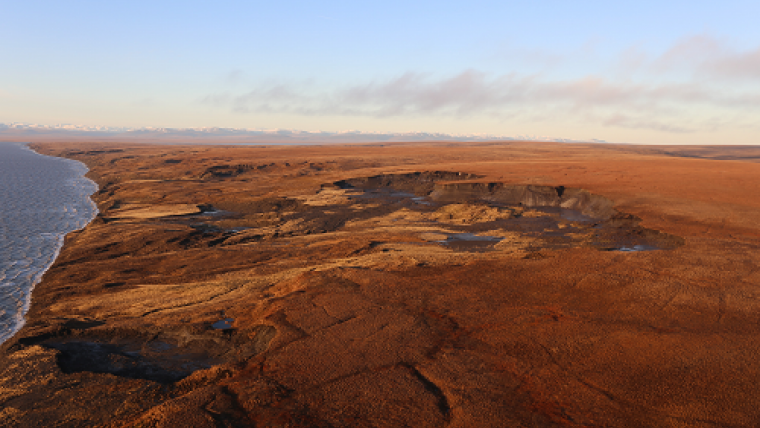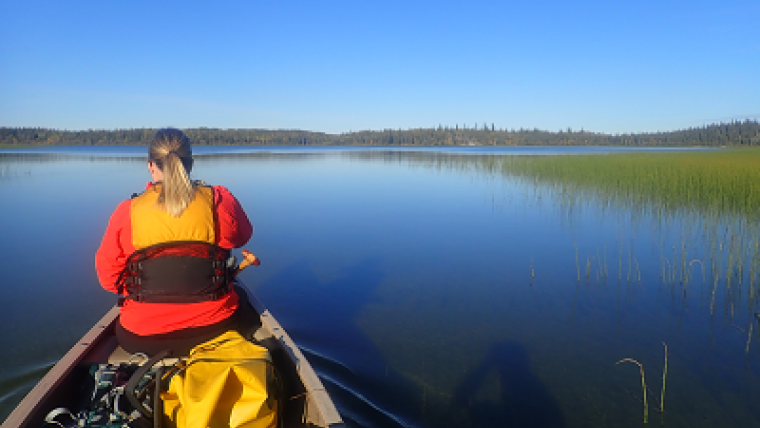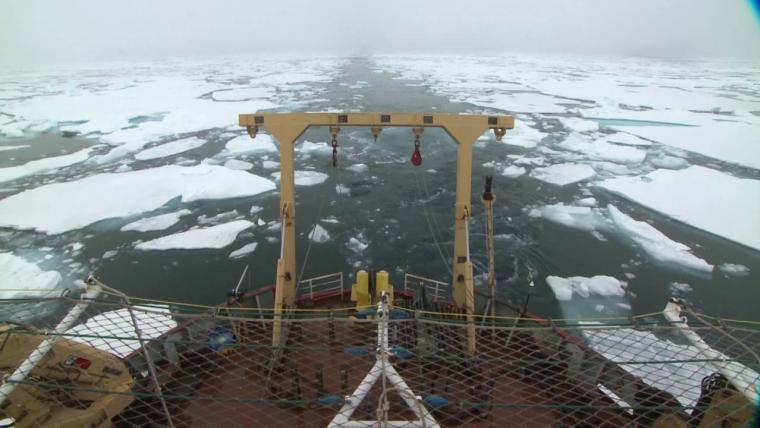Research in the Arctic (Natural Elements)
Have you ever wondered what it’s like to conduct research up North? Like, way up North, in the middle of the Arctic, in the middle of nowhere up North? David Mate from the Polar Continental Shelf Program joins us to talk about how his team supports nearly 1,000 people per year to conduct scientific research in some of the most extreme conditions.
Transcript
Barbara Ustina (Host): Have you ever wondered what it’s like to do research up north? Like, way up north, in the middle of the Arctic, in the middle of nowhere up north?
Where there’s snow and ice all year round. Unexpected wildlife intruders. Remote, exotic locations.
If that sounds like you, the Polar Continental Shelf Program has your back.
Science is hard enough. So the Polar Continental Shelf Program provides logistics, coordination and advice for researchers ready to take the Arctic plunge.
What exactly does the Polar Continental Shelf Program do? We’re about to find out.
Music intro
This is Natural Elements, and I’m your host, Barbara Ustina.
Natural Elements is a podcast series brought to you by Simply Science, which is Natural Resources Canada’s online magazine. We talk to our experts about the work they do and how it relates to the world around us. We’ll give you a taste of the topic and let you know where you can find more information.
Let’s get to today’s topic: The Polar Continental Shelf Program, often referred to as PCSP.
Let’s say you’re planning to do leading-edge scientific research in the Arctic. You know it’s going to take more than just a keen sense of adventure. So one of your first points of contact would be PCSP. They’re here to help.
In 2018, the program supported nearly one-thousand people. So if anyone knows what it’s like to thrive in Canada’s north, it’s the team of experts at PCSP.
It takes hours, months, sometimes, years of preparation. . The level of coordination — the amount of specialized gear and custom vehicles needed just to get there — may surprise you.
But it’s vital work. From climate change to natural hazards to sustainable natural resource development, Arctic science is key to planning our future.
We got in touch with program director David Mate. We asked him what a researcher planning to work in Canada’s Arctic needs to know before they go:
David Mate: A few of the things that scientists maybe don’t often remember to do when they’re doing research in the North is community engagement, is really important now for all scientific research done in the North. Having a good health and safety plan is really critical because we’re often putting people out in really the middle of nowhere in a very extreme environment where there are some polar bears and other significant predators. And another nuance, which I think is good for a scientist to remember is that in the North there are often some additional permitting requirements as well to get permission to do your research. You have to fill in certain permits, whether it’s a water license, or access to crown lands, or even access to, for example, Inuit-owned lands.
Barbara Ustina: So that’s the first thing. There is a LOT of paperwork.
In 2018, PCSP supported over 160 projects in the north. And they take on new ones only once a year.
So in their applications, researchers must thoroughly describe the type of research they’d like to do, list where they want to go and the equipment they need. Once approved, the PCSP team begins to work their magic.
David Mate: If you make it through our process, then we would follow up with you, then we would in more detail coordinate your logistics requirements, we would start scheduling airplanes for you and determine the types of airplanes, if you need it, to get to your field site.
Barbara Ustina: Covering five million square kilometres and thirty-six thousand islands, flying is the only way to get around Canada’s Arctic….. jumping in your car is impossible. All in, last year PCSP clocked in nearly 4,000 hours of chartered aircraft time — that works out to over five months of non-stop flying. And it takes an impressive fleet of aircraft to get researchers where they need to be… from the Yukon–Alaska border, to the shores of Labrador, all the way up to the northern tip of Nunavut.
David Mate: The aircraft we use is quite diverse. Our real workhorse that we use is a Twin Otter, and we can set up these planes to land on the tundra, and we can also put skis on them. There’s other planes we can use that have floats that can land on water, we can use larger planes if we need to transport heavier or larger amounts of equipment. And, of course, a lot of scientists once they get to their camp, and if they need to travel around their study area would require access to helicopters.
Barbara Ustina: The PCSP also provides living and working space in Resolute. It’s one of the most northerly and isolated communities in Nunavut. It’s a bustling hub for researchers to eat, sleep, relax and socialize after spending long days in the field.
Really long days. Dealing with 24 hours of daylight in summer can be challenging at first. But the team will ensure you feel right at home and well fed, even if your new home is in the High Arctic.
David Mate: We have a really great kitchen and staff that work really hard at making sure everyone is well-fed and happy. A couple years ago in 2018 that group served over 40,000 meals in the course of our season, so it’s very busy.
And not only are they cooking at quite a high volume, but they are also very accommodating for dietary needs. I have not heard of anyone, any client or any visitor, who has had a particular need and not getting the service and food that they require. Pretty impressive when you’re way far north in the middle of nowhere.
Barbara Ustina: Getting food and field equipment to far-flung corners of the region is no easy task. One way to get around this is by storing gear in warehouses located in both Ottawa and Resolute — ready to be shipped anywhere in the Canadian Arctic. In 2018 alone, the amount of equipment and gear shipped north weighed roughly 550 tonnes, about the weight of 290 beluga whales!
David Mate: So, quite a lot of gear that our folks are providing to researchers, at their field location, and it’s really important that we make sure what we provide is cutting edge, is customized or for severe climates so that the people who are using it are safe and secure. My staff spend - it’s kind of a fun job - a lot of time researching, whether it’s online or at trade shows, the latest and greatest in outdoor gear.
Barbara Ustina: Each and every item is designed and tested to withstand the extreme weather conditions. In fact, PCSP is so well known for its rigorous research that it’s often asked to evaluate new products.
Currently, they’re testing solar-powered equipment and electric vehicles, and working. with companies to make sure that portable items, like tents, are lightweight and durable.
David Mate: When we talk about innovation in our field equipment, recently we’ve had a conversation with an organization called Innovative Solutions Canada, which is a Government of Canada program that’s focused on supporting entrepreneurs who are developing new types or products for the market, but they haven’t hit the market yet. They need testbeds to test these new ideas. We’re in the process of acquiring electric skidoos and electric ATVs so we can test them in our climate, in our environment, in our remote Arctic reality. And who knows, some day if the technology is robust enough, this might be a way we can enhance what we provide to our clients. It’s greener, maybe performs well. It’s really exciting, actually.
Barbara Ustina: Another crucial aspect of the PCSP’s work is engaging with local communities. While the program supports visiting scientists in the region, it’s also vital to the people who live there. David says one way the program is strengthening and deepening ties locally is through Inuit employment and training programs.
David Mate: We’ve spent some time fostering relationships with Nunavut Arctic College trades program. Last summer we were successful having our first apprentice from that program work at our facility over the summer, getting hours towards his apprenticeship in being an electrician.
Barbara Ustina: There are a number of different ways PCSP gets involved. For one, it’s exploring ways to reduce its environmental footprint.
David Mate: We have an incinerator at our facility so we do not have to dispose of our garbage in a sensitive Arctic environment. We are discussing ways to provide opportunities for the hamlet as well to also access this incinerator to reduce their footprint as well.
Barbara Ustina: PCSP also looks for opportunities that might benefit local businesses.
David Mate: One recent success for us is we have our large food contract now in place with Arctic Co-operatives Limited, which actually has a store in Resolute. So now, because we have a contract with this organization, there’s more produce flying into town for the local community, and because it’s a co-op there’s dividends and benefits that go to the local community. There’s some really interesting ways just through procurement where we can also enhance our engagement and build capacity in the community.
Barbara Ustina: So as we’ve just heard, PCSP has your back if you think Arctic research is right for you. It’s a pretty massive job making sure Canadian scientists and researchers are well prepared for their northern projects.
For some of them, it may be the only time they’re able to make the journey to the Arctic. And the Polar Continental Shelf Program is here to help them make the most of it.
To learn more about the program, check out the links in the episode description.
Don’t miss future episodes of Simply Science — subscribe to our podcast channel.
And to learn more about the fascinating scientific work that we do at Natural Resources Canada, check out our Simply Science website for in-depth articles and also our Simply Science YouTube channel to see our experts at work. You can find the links in the episode description as well.
Thank you, everyone, for listening! We’ll see you next time with a brand new episode.
Page details
- Date modified:


